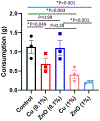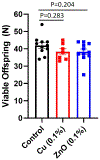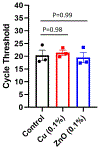Effects of copper and zinc oxide nanoparticles on German cockroach development, indoxacarb resistance, and bacterial load
- PMID: 36966487
- PMCID: PMC10330183
- DOI: 10.1002/ps.7472
Effects of copper and zinc oxide nanoparticles on German cockroach development, indoxacarb resistance, and bacterial load
Abstract
Background: The German cockroach, Blattella germanica, is a ubiquitous and medically significant urban pest. The ongoing development of insecticide resistance in global populations of B. germanica has complicated control efforts and created a need for improved tools. We previously reported that disruption of the gut microbiota by oral administration of the antimicrobial doxycycline reduced resistance in an indoxacarb resistant field strain and also delayed nymphal development and reduced adult fecundity. However, the application of doxycycline for cockroach control in the field is impractical. Here, we sought to determine whether two metal nanoparticles with known antimicrobial properties, copper (Cu) and zinc oxide (ZnO), have similar effects to doxycycline on the physiology of B. germanica and could provide more practical alternatives for control.
Results: We found that dietary exposure to 0.1% Cu nanoparticles, but not ZnO, significantly delays the development of nymphs into adults. However, neither of the nanoparticles altered the fecundity of females, and ZnO surprisingly increased resistance to indoxacarb in a resistant field strain, in contrast to doxycycline. Semi-quantitative polymerase chain reaction (qPCR) further revealed that prolonged dietary exposure (14 days) to Cu or ZnO nanoparticles at the low concentration readily consumed by cockroaches (0.1%) does not reduce the load of the bacterial microbiota, suggesting alternative mechanisms behind their observed effects.
Conclusions: Together, our results indicate that ingestion of Cu nanoparticles can impact German cockroach development through an undetermined mechanism that does not involve reducing the overall load of the bacterial microbiota. Therefore, Cu may have some applications in cockroach control as a result of this activity but antagonistic effects on insecticide resistance should be considered when evaluating the potential of nanoparticles for cockroach control. © 2023 Society of Chemical Industry.
Keywords: German cockroach; bacteria; copper; development; indoxacarb resistance; microbiota; nanoparticle; zinc.
© 2023 Society of Chemical Industry.
Conflict of interest statement
CONFLICT OF INTEREST
The authors have no conflicts of interest. Chen Zha and Dang-sheng Liang are employed by Apex Bait Technologies, Inc.
Figures





Similar articles
-
Microbe-mediated activation of indoxacarb in German cockroach (Blattella germanica L.).Pestic Biochem Physiol. 2022 Nov;188:105234. doi: 10.1016/j.pestbp.2022.105234. Epub 2022 Sep 16. Pestic Biochem Physiol. 2022. PMID: 36464351
-
Disruption of the microbiota affects physiological and evolutionary aspects of insecticide resistance in the German cockroach, an important urban pest.PLoS One. 2018 Dec 12;13(12):e0207985. doi: 10.1371/journal.pone.0207985. eCollection 2018. PLoS One. 2018. PMID: 30540788 Free PMC article.
-
Insecticide resistance and diminished secondary kill performance of bait formulations against German cockroaches (Dictyoptera: Blattellidae).Pest Manag Sci. 2016 Sep;72(9):1778-84. doi: 10.1002/ps.4211. Epub 2016 Jan 27. Pest Manag Sci. 2016. PMID: 26689433 Free PMC article.
-
Unidirectional Cross-Resistance in German Cockroach (Blattodea: Blattellidae) Populations Under Exposure to Insecticidal Baits.J Econ Entomol. 2017 Aug 1;110(4):1713-1718. doi: 10.1093/jee/tox144. J Econ Entomol. 2017. PMID: 28541548
-
An overview of German cockroach, Blattella germanica, studies conducted in Iran.Pak J Biol Sci. 2010 Nov 15;13(22):1077-84. doi: 10.3923/pjbs.2010.1077.1084. Pak J Biol Sci. 2010. PMID: 21313881 Review.
Cited by
-
Endosymbiont and gut bacterial communities of the brown-banded cockroach, Supella longipalpa.PeerJ. 2024 Mar 19;12:e17095. doi: 10.7717/peerj.17095. eCollection 2024. PeerJ. 2024. PMID: 38525276 Free PMC article.
-
The gut microbiota confers resistance against Salmonella Typhimurium in cockroaches by modulating innate immunity.iScience. 2024 Oct 30;27(12):111293. doi: 10.1016/j.isci.2024.111293. eCollection 2024 Dec 20. iScience. 2024. PMID: 39628558 Free PMC article.
-
The gut microbiota induces melanin deposits that act as substrates for fimA-mediated aggregation of Salmonella Typhimurium and enhance infection of the German cockroach vector.Microbiol Spectr. 2023 Aug 22;11(5):e0211923. doi: 10.1128/spectrum.02119-23. Online ahead of print. Microbiol Spectr. 2023. PMID: 37606369 Free PMC article.
-
Development and Optimization of a Nanoparticle-Based Imidacloprid Insecticide for Effective Control of Blattella germanica.J Arthropod Borne Dis. 2024 Jun 30;18(2):137-148. doi: 10.18502/jad.v18i2.17535. eCollection 2024 Jun. J Arthropod Borne Dis. 2024. PMID: 39850257 Free PMC article.
-
The multifaceted roles of gut microbiota in insect physiology, metabolism, and environmental adaptation: implications for pest management strategies.World J Microbiol Biotechnol. 2025 Feb 27;41(3):75. doi: 10.1007/s11274-025-04288-9. World J Microbiol Biotechnol. 2025. PMID: 40011281 Review.
References
-
- Nasirian H, Infestation of cockroaches (Insecta: Blattaria) in the human dwelling environments: a systematic review and meta-analysis. Acta Trop 167:86–98 (2017). - PubMed
-
- Nasirian H, Contamination of cockroaches (Insecta: Blattaria) to medically fungi: a systematic review and meta-analysis. J Mycol Med 27:427–448 (2017) - PubMed
-
- Nasirian H, Contamination of cockroaches (Insecta: Blattaria) by medically important bacteriae: a systematic review and meta-analysis. J Med Entomol 56:1534–1554 (2019). - PubMed
-
- Peters JL, Levy JI, Muilenberg ML, Coull BA and Spengler JD, Efficacy of integrated pest management in reducing cockroach allergen concentrations in urban public housing. J Asthma 44:455–460 (2007). - PubMed
-
- Rabito FA, Carlson JC, He H, Werthmann D and Schal C, A single intervention for cockroach control reduces cockroach exposure and asthma morbidity in children. J Allergy Clin Immunol 140:565–570 (2017). - PubMed
MeSH terms
Substances
Grants and funding
LinkOut - more resources
Full Text Sources

